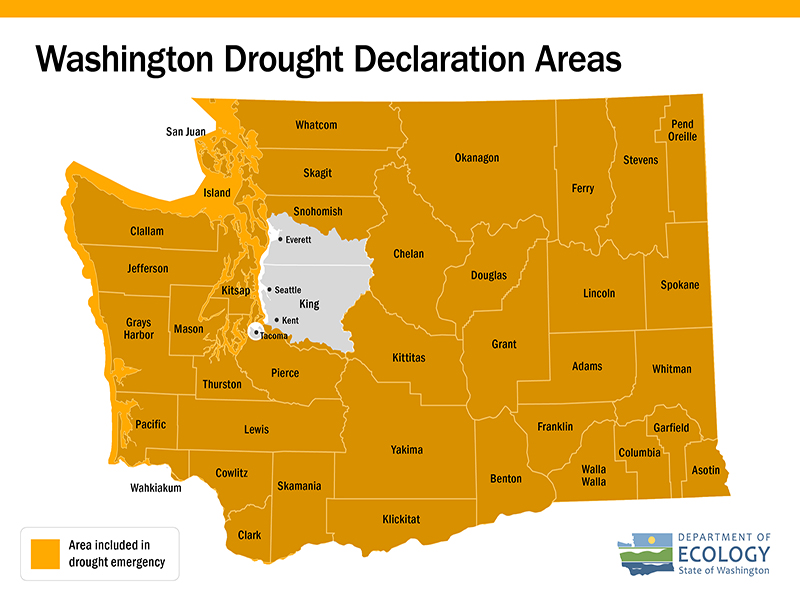
The drought emergency declaration issued in July 2021 is scheduled to expire in June 2022. While the necessity to extend the drought declaration has yet to be confirmed, for parts of the state it’s very likely.
Several streams in Southeastern Washington — including the Walla Walla River, the Palouse River, Hangman Creek and the Little Spokane River — are forecasted to have low flows this year according to our Statewide Drought Coordinator, Jeff Marti.
Conditions have improved since last summer, but even if the state receives unusually heavy snow and rainfall in the next few months, it is very unlikely it will be enough to negate the ongoing water supply deficits in much of Eastern Washington.
Washington water law provides for a drought emergency declaration when an area’s water supply is less than 75 percent of normal and causes undue hardship. We issued a drought emergency declaration on July 24, 2021, for most of Washington. Three watersheds — including the Everett, Seattle, and Tacoma metropolitan areas — were determined to have adequate water supplies for people and fish, and therefore excluded from the declaration.
The current drought declaration will expire on June 1, 2022, unless extended. During a drought declaration, we typically have several tools to mitigate hardships on people, agriculture, and the environment:
- Issuing temporary drought permits for alternate sources to water right holders unable to access fully their normal water supply source
- Permitting temporary water right transfers between willing parties
- Leasing water from willing water right holders to put into or to remain in-stream
- Offering grants to public entities for projects to mitigate the effects of drought (this option is generally available when the state Legislature has allocated funds for this purpose)
What does this mean for water users?
Washington water law is based on the prior appropriation doctrine — “first in time, first in right.” This means the full measure of senior water rights take priority over any portion of water rights established later. This includes adopted instream flows, which are streamflow levels set in rule that are protected from further appropriation.
When water supplies are low, junior water uses may be curtailed to protect senior rights, including any senior instream flows that would be impaired by the use. There are some areas of the state where junior water uses receive curtailment orders nearly every year, but in low water years they may occur earlier than normal.
Options
- You may be able to locate and lease a senior, more reliable, water right from a nearby or upstream water right holder. Use our water right search tool to help identify your options.
- Temporary drought permits for an alternate source may be available to water right holders unable to access the full measure of their right from their existing water source.
If you don’t have a water right
If you receive your water from a public water supplier or irrigation district, you are covered under their water right portfolio. They will communicate any advisements or limitations for your use.
We do not currently have tools to aid dryland farmers and ranchers reliant on unirrigated forage, as they have no irrigation water rights, but water right leases may be an option for you if you are able to locate a willing right holder. (See first bullet under Options above.)
Permit-exempt well users
Although certain groundwater uses are exempt from permitting under RCW 90.44.050, all other aspects of water law apply to these uses and they are legal water rights. Typically, the start of the actual water use (rather than the date the well was drilled) establishes the priority date of a permit-exempt use, such as the approval for occupation of a new home.
Where to find help
While Ecology is the state agency responsible for declaring drought, we’re not the only agency involved in drought relief. Various state agencies share responsibility for helping people get through drought emergencies.
- For drinking water emergencies due to the drought, please contact the Washington Department of Health’s Office of Drinkwater Water Hotline at 1-877-481-4901.
- For fish health emergencies due to the drought, please contact the Washington Department of Fish and Wildlife's Fish Program at (360) 902-2700.
- For agricultural emergencies (potential for loss of life of agricultural animals or crops) due to the drought, please contact the Washington State Conservation Commission at (509) 385-7509.
Learn more about water supply and drought status
We update our Statewide conditions page every month. This includes a link to the latest issue of the Office of the State Climatologist’s Newsletter. You can find current data about streamflow, snowpack, precipitation and more on our Water Supply Monitoring page. Some of these resources are updated as frequently as every 15 minutes.

